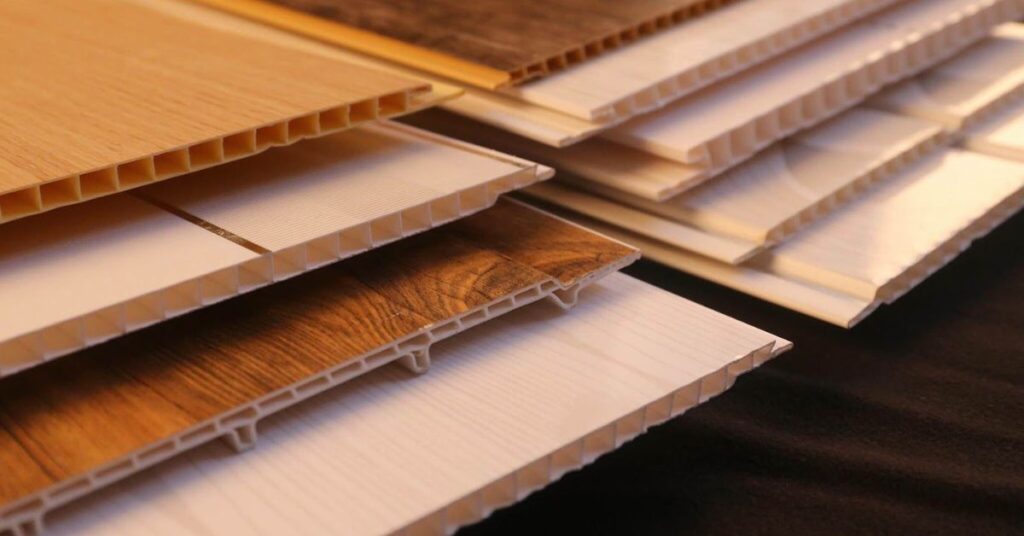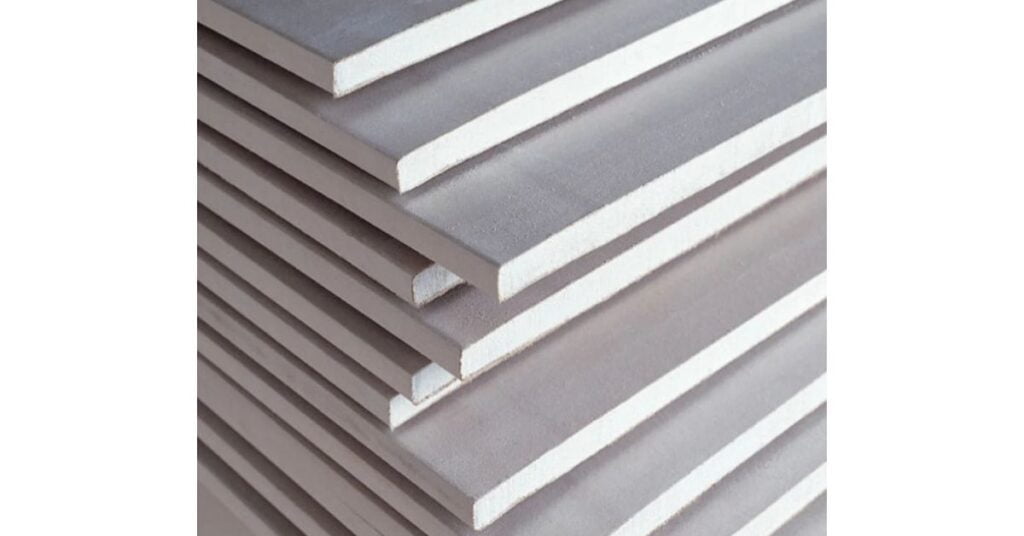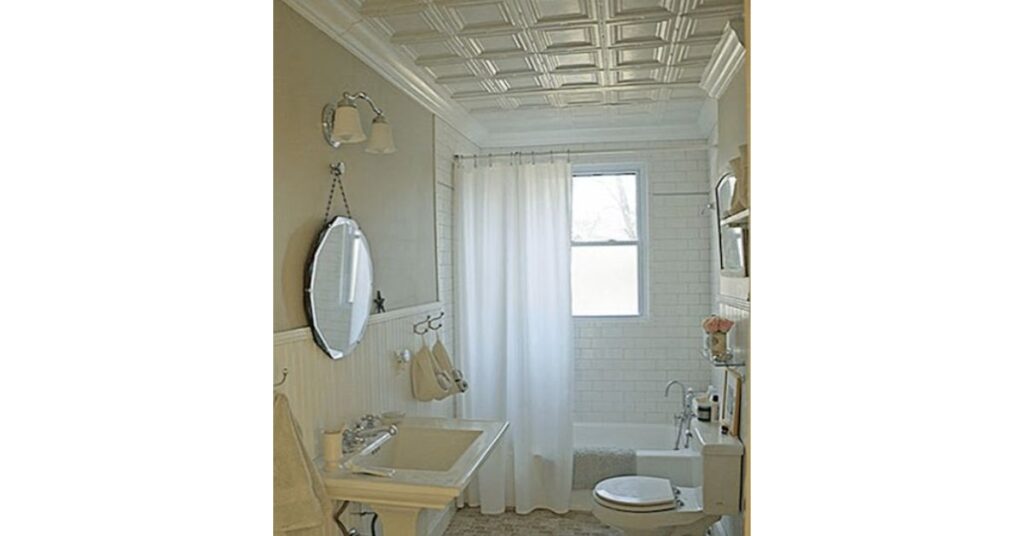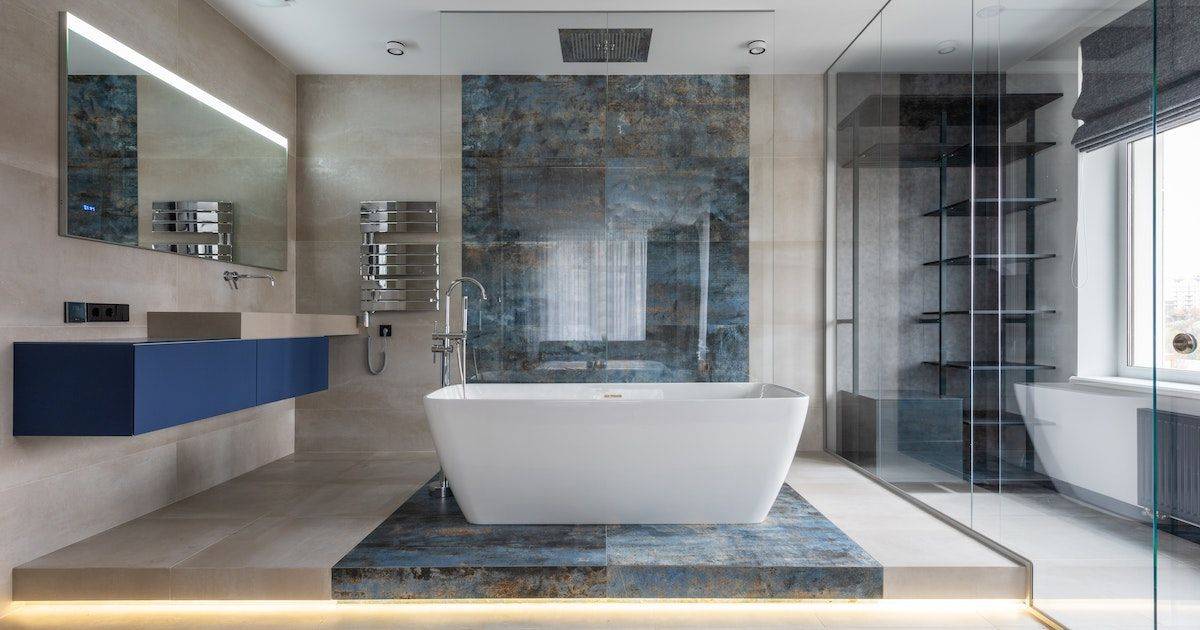It is important to choose the best bathroom Ceiling Materials because they can affect the room’s overall feel and appearance as well as its usability and durability.
The best bathroom Ceiling Materials are ones that can endure the special difficulties that come with a high moisture environment.
Bathrooms are frequently filled with steam, water, and high levels of humidity, which can harm various ceiling materials like plasterboard or untreated wood.
According to the world construction today report due to water leakage bathroom ceiling gets damaged easily so we have to choose the material accordingly.
Several different ceiling materials are suitable for use in bathrooms. For instance, PVC panels are a preferred choice since they are inexpensive, weatherproof, and simple to maintain.
The durability and resistance to moisture, mold, and mildew of fiber cement board and metal tiles make them excellent options as well.
We will examine the most popular bathroom ceiling materials in this article and go through their benefits and drawbacks so you can make a proper choice.
5 Factors to Consider when choosing the Best Bathroom Ceiling Materials:
there are 5 factors we listed below that you should keep in mind when selecting the Best Bathroom Ceiling Materials.
- Moisture resistance: Because bathrooms are high-moisture spaces, the material used for the bathroom ceilings must be able to survive exposure to moisture and humidity without degrading. Selecting a material that is waterproof or at least water-resistant is crucial.
- Durability: The material used for the ceilings should be able to handle normal wear and tear as well as damage from moisture, dampness, and mildew. For bathrooms that are regularly used or have high humidity levels, this is especially crucial.
- Aesthetics: The bathroom ceiling material should blend with the room’s general décor and enhance its appeal. Options may include ornamental tiles, bead board, or smooth plasterboard, depending on the bathroom’s design.
- Installation simplicity:: The ceiling material installation procedure has to be simple and not call for a lot of expert help. This can speed up the renovation process and reduce costs.
- Requirements for maintenance: The ceiling material should be simple to maintain over time. This can help the material last longer and stop the growth of mold or mildew.
Homeowners can choose The best ceiling material for a bathroom that is both practical and aesthetically pleasing by considering these things.
Popular Bathroom Ceiling Materials:
You can select from several common best bathroom ceiling materials that are long-lasting, moisture-resistant, and aesthetically pleasing.
PVC panels:

Because PVC panels are waterproof and mold-resistant, PVC panels are a popular option for bathroom ceilings. Additionally, they are simple to install and we can clean them with cleaner.
The following are a few advantages of using PVC panels:
- PVC panels are extremely water-resistant, which makes them a great option for bathrooms. The ceiling will continue to look nice for many years because they are resistant to rot, water damage, and mold growth.
- PVC panels are lightweight and simple to install, making them a popular option for do-it-yourself home improvements. They can be attached using adhesive or clips after being cut to size using a utility knife.
- Low upkeep: Other than the occasional wipe-down with a moist cloth, PVC panels need little to no maintenance. They don’t need to be painted, stained, or sealed.
- Cost-effective: PVC ceiling panels are a more cheap option than ornamental plasterboard or metal tiles.
There are several drawbacks to adopting PVC panels
- A few available design possibilities PVC panels come in a small selection of styles and designs, which might not appeal to every homeowner’s aesthetic preferences or personal taste.
- Damage-prone: PVC panels are water-resistant, but they are also readily scratched or dented. For households with kids or pets, this can be a concern.
PVC panels are an excellent alternative for a bathroom ceiling overall since they are maintenance-free and weatherproof.
Before making a final choice, it’s crucial to take into account this material’s drawbacks, such as its fragility and constrained design alternatives.
Acrylic Sheets

A synthetic polymer called polymethyl methacrylate (PMMA) is a substance material in acrylic sheets. They can be transparent, translucent, or colored, and they are available in various thicknesses. Acrylic sheets offer a range of benefits that make them suitable for the best bathroom ceiling Materials.
The following are a few benefits of employing acrylic sheets:
Moisture Resistance: Acrylic sheets are extremely moisture-resistant, which makes them perfect for bathroom settings. They do not absorb water, which aids in avoiding damage brought on by problems with moisture and humidity, such as the development of mold and mildew.
Lightweight: Acrylic sheets are easier to handle and install on the ceiling because they are lighter than glass. They are a sensible option because of how lightweight they are, which reduces stress on the ceiling structure.
Aesthetic Appeal: Acrylic sheets give bathroom ceilings a sleek, contemporary appearance. They are customizable to the desired bathroom decor thanks to their wide range of colors, finishes, and textures. Acrylic sheets can produce a stylish and modern atmosphere.
The use of acrylic sheets as a bathroom ceiling material has a few drawbacks, though:
Scratches: If handled carelessly, acrylic sheets are vulnerable to scratches. Despite having good scratch resistance, they can still become scratched over time by using abrasive materials or improper cleaning methods are best bathroom ceiling materials.
Thermal Expansion: When compared to other materials, acrylic sheets have a higher coefficient of thermal expansion. This means that they can expand or contract in response to temperature changes, which, if improperly installed, could result in tiny gaps or cracks.
Chemical Sensitivity: Acrylic sheets can be damaged by some chemicals, including harsh cleaners and solvents. Cracks, surface damage, and discoloration may result from exposure to these substances. It’s crucial to use cleaning supplies that are compatible and to stay away from chemicals that might harm the material.
Overall, acrylic sheets have many benefits as the best bathroom ceiling materials, including UV resistance, impact resistance, moisture resistance, lightweight design, and aesthetic appeal. Care must be taken to prevent abrasions and contact with toxic substances.
Board made of fiber cement:

this is incredibly resilient and resistant to moisture, mold, and mildew. It is a secure solution for usage in restrooms because it is also fire-resistant.
Best bathroom ceiling Materials frequently employ fiber cement board, which is a highly resilient material.
The following are a few benefits of employing fiber cement board:
Moisture-resistant: Due to its exceptional moisture resistance, fiber cement board is perfect for use in bathrooms. When exposed to water, it does not rot, deform, or deteriorate over time.
fire-resistant: Fiber cement board is also fire-resistant, which adds an important layer of security to any home.
Durability: Fibre cement board has a high level of resilience and is impervious to impact, weather, and pest damage. Compared to other ceiling materials, it is also less likely to warp, break, or split.
Fiber cement boards can be made to resemble other materials like wood, brick, or stone. It is also a diverse aesthetic choice. To match the bathroom’s general design, it can also be painted in a variety of hues.
The use of fiber cement board as the bathroom ceiling material has a few drawbacks, though:
Heavy: Installing a fiber cement board might be challenging due to the weight of the material. This can require hiring a professional installer or raising installation fees.
Dusty: Fibre cement board installation can generate a lot of dust, which may be an issue for those with allergies or respiratory problems.
Costlier: Compared to alternative bathroom ceiling materials like PVC panels or beadboard, fiber cement board is more expensive.
The durability and moisture resistance of fiber cement board makes it an appealing alternative for homeowners searching for long-lasting and low-maintenance and best bathroom ceiling materials, despite the increased cost and installation difficulties.
Metal tiles:

Metal tiles can provide the best bathroom ceiling materials with a distinctive and contemporary appearance. Additionally, they have a long lifespan and are mold and moisture-resistant.
A contemporary and chic alternative for bathroom ceilings is metal tiles.
The following are some benefits of employing metal tiles for the bathroom ceiling:
Durability: Metal tiles have a high level of resilience and are fire, water, and impact resistant. They are low maintenance and able to survive the test of time.
Aesthetically pleasing: Metal tiles give any bathroom a sleek, contemporary feel. They come in a variety of textures and finishes, such as matte, polished, and embossed.
Simple to install: Waterproof plasterboard is comparatively simple to install, requiring fewer specialized tools and skills than other ceiling materials like tiles or metal.
Versatile: Waterproof plasterboard is a flexible solution for any design scheme because it can be painted or tiled to fit any bathroom décor.
Affordable: Waterproof plasterboard is comparatively inexpensive compared to other ceiling materials, making it an economical choice for bathroom renovation projects.
there are a few drawbacks also you should take into consideration:
Limited load-bearing capacity: Waterproof plasterboard is not advised for use in areas where heavy things may be stored, such as over a shower, because it is not suited for supporting heavy loads.
Mold-prone: Waterproof plasterboard is resistant to water damage, but if it is not put correctly or is exposed to a lot of moisture for a lengthy period, mold can still grow on it.
needs suitable ventilation: When utilizing waterproof plasterboard in a bathroom ceiling, adequate ventilation is crucial to preventing the spread of mold. To guarantee optimum air circulation, this may require additional installation or ventilation systems.
Damage-prone: Care must be given when handling or installing waterproof plasterboard since it is easily harmed if it comes into contact with heavy or sharp items.
Beadboard:
Adding a touch of historic charm to the space, bead board is a time-honored alternative for the best bathroom ceiling materials. It is very moisture-resistant and made of PVC or wood.
A narrow, vertical paneling style known as beadboard consists of planks with a unique ridge, or “bead,” along the length of each one.
The followings are some benefits and drawbacks of beadboard bathroom ceilings:
Simple to install Beadboard is a common material for do-it-yourself home improvement projects because it’s reasonably simple to install. The panels can be sized to fit and nailed or glued to the ceiling.
Beadboard has a traditional, timeless appearance that may give texture and character to a bathroom. To fit any décor, it is offered in a variety of finishes, including painted or stained.
Beadboard is strong and resistant to wear and tear since it is composed of premium wood or composite materials. It can endure high moisture levels without warping or decaying.
Beadboard is a cost-effective solution for homes on a tight budget because it is a reasonably priced option for bathroom ceilings.
Disadvantages:
Beadboard needs to be well maintained to avoid water damage or the formation of mold. It needs to be sealed or painted to guard against moisture, and any water stains need to be cleaned up right once to stop the growth of mold.
Limited design options: Although bead board is available in a range of finishes, not all design schemes may be acceptable for it. Its old, rustic appearance might not be suitable for bathrooms that are modern or minimalist.
Cleaning bead boards can be challenging since the ridges can trap dust and filth. It can need regular vacuuming or dusting to maintain its best appearance.
Needs a smooth surface: To maintain a tight fit and prevent gaps or warping, the bead board should be laid on a smooth, level surface. Before installation, any imperfections in the ceiling might need to be fixed or covered.
It’s crucial to take both the intended aesthetic and the particular requirements of the area into account when selecting a bathroom ceiling material. Homeowners may guarantee that their bathroom ceiling is both functional and aesthetically pleasing by selecting one of these best bathroom ceiling materials.
Conclusion
In this article, we’ve covered 5 cheap and common best bathroom ceiling materials.
We have highlighted the special qualities and features of each material while listing its benefits and drawbacks.
Considerations for the ideal best bathroom ceiling materials include moisture resistance, toughness, cost, ease of installation, and maintenance requirements.
Based on these elements, waterproof plasterboard can be the best choice for individuals who value price, simplicity of installation, and water resistance.
Beadboard, on the other hand, might be a better option for people who like texture, robustness, and a traditional appearance.
The best bathroom ceiling materials ultimately depend on personal preferences and requirements.
Homeowners should consider all of their alternatives carefully and select the one that best fits their needs.
thank you for your valuable time, hope you enjoy reading this article and it will help you.
FAQ: 5 best Bathroom Ceiling Materials and Practical Upgrade
What qualifies a ceiling material as bathroom-appropriate?
The best bathroom ceiling Materials should be made of a moisture-resistant material that can endure high humidity levels. It should be strong and simple to maintain.
What types of ceiling materials are most frequently used in bathrooms?
Bathroom ceilings frequently employ metal tiles, weatherproof plasterboard, beadboard, and PVC panels.
How do I decide which ceiling material is ideal for my bathroom?
Take into account elements like water resistance, durability, ease of installation, maintenance, and cost when choosing the ceiling material for your bathroom.
In a bathroom with a low ceiling, is it possible to install a ceiling fan?
in a bathroom with a low ceiling, a ceiling fan can be installed. However, you might need to select a fan with a flush mount and a specific low-ceiling design.
How can I keep the ceiling in my bathroom in good condition?
Regularly cleaning a bathroom ceiling with a light cleaning agent and a soft cloth will keep it in good condition and avoid damage. As soon as possible, fix any damage or gaps to stop moisture from seeping in. To get rid of too much humidity in the bathroom, use air fans.
Also Read:
Transform Your Bathroom With Stunning Styrofoam Ceiling Tiles
